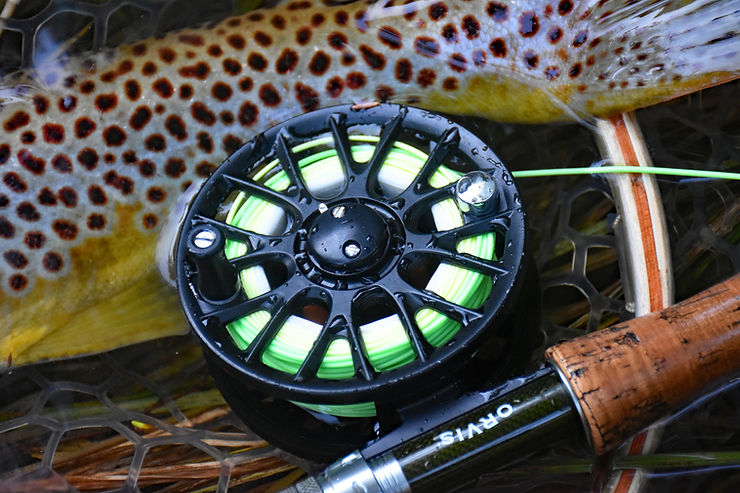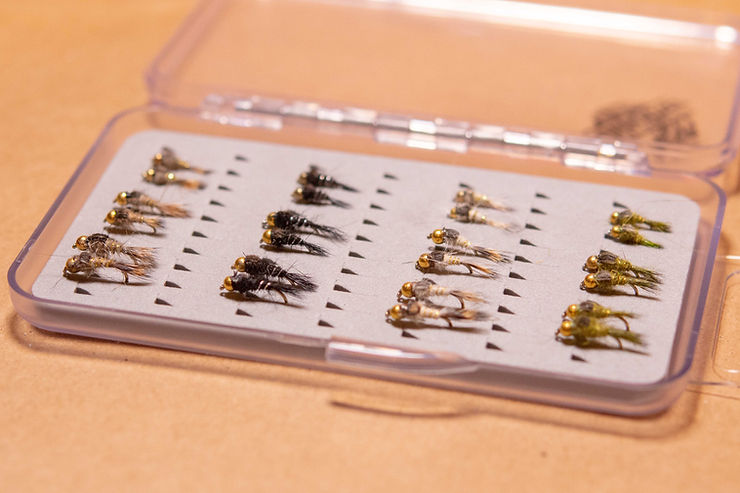How to Choose a Fly Reel

A fly reel serves basic functions. It holds the fly line and backing as well as offers a rudimentary drag system for playing larger fish. Like many products in life that we use and often take for granted, you won’t give the fly reel much thought until it stops working.
My first fly outfit was a St. Croix rod and reel combo that sustained a decade of heavy use. Not bad for what amounted to a $100 setup. Experimenting with new and better (and often more expensive) equipment is a natural progression for anyone interested in a sport, so it wasn’t long until I saved up and bought my first high quality rod, a St. Croix Legend Elite. It was a work of art and felt light as a feather in my fingertips. It just didn’t make sense to equip a $450 rod with a $20 reel.
The local fly shop carried Redington products and at that time had a model that cost around $100. It took the last of my savings, but I bought it. Almost 30 years later I still have that reel and use it frequently. Over the years, it has been frozen countless times, banged off of rocks, bounced around in truck beds, and logged thousands of hours on the water, and it has never failed. Not once.
By comparison, a handful of years ago I bought a Quarrow fly rod and reel combo for about $120 to use after I broke my main rod on a fishing trip and needed a quick replacement. Eventually, I gave the Quarrow rod to a friend who was new to fly fishing, and since he already had a reel, I kept the one that came with the combo. After two years of heavy use, the reel was trashed.
Two years is pretty good for a cheap reel. But if you consider its cost (approximately $30) compared to the cost of the Redington ($100), and then factor in the number of years that each model lasted (2 versus 30, respectively), you can see that the Redington was a much better deal.
I’m not preaching the quality of Redington here, although I definitely feel comfortable using their products, and I’m certainly not bashing Quarrow. More accurately, this experience is a good reminder that you should always purchase the highest quality equipment you can afford, even if it takes your last expendable penny – the operative word there, of course, is “expendable”…nobody should starve their children just so they can buy a quality reel.
Expensive models can break, too, and occasionally are flawed. But by and large, how much you pay for a reel is directly correlated to the quality of the parts used to make the reel.
Nowadays, a cheap reel will run $30 to $60. For the most part, these reels are serviceable and reliable under most fishing conditions. If taken care of properly (meaning cleaned regularly) they’ll last a number of years. Recently I purchased a Cabela’s Prestige Plus Fly Reel ($40) as a backup and so far I’ve been very happy with it. But it is a backup and only used occasionally.
High end reels often exceed $300. A LOOP Classic Fly Reel model 1013, for example, retails for $769.00. That’s a chunk of money to invest in something whose primary function is to hold your line. However, if I could afford one, I’d certainly add it to my collection.
The bulk of the fly reels on the market fall between $80 and $200, and most of them are built with exceptional quality that will last. It would be difficult to find a clunker in this price range.
In 2020, I purchased a TFO Drift Rod (for Euronymphing) outfitted with a TFO BVK reel. Individually, the reel costs in the neighborhood of $250. In only two years, I’ve beat the snot out of this reel, never cleaned it, left it in my truck for months at a time, and it still operates as if I’d just pulled it new from the box. It is hands down my favorite reel I’ve ever purchased and worth every penny.
Perhaps the main reason for the TFO BVK’s longevity is its sealed bearing and sealed drag design. This keeps water out of all of the “guts” of the reel, so to speak, so they don’t rust. Now that I’ve experienced this feature, it’s definitely something I’ll look for in a reel in the future.

(Photo: The TFO BVK reel has served me well. I’m hard on equipment, but this reel has held up tremendously and still feels new.)
The most important part of choosing a fly reel, of course, is first choosing a fly rod. Once you’ve selected the length and weight of the rod, deciding which reel to purchase should reflect several factors.
First, the rod and reel should have good balance. You shouldn’t notice the weight of each one more than the other. Rather, their weight should compliment each other, like a teeter totter.
Second, because your rod choice was directly related to the species you wish to pursue, and the conditions in which you wish to pursue them, the reel should be able to meet those demands as well. It should be able to hold enough line to get the job done. For instance, if I’m using a 6-weight rod, I select a reel designed to hold enough backing and fly line ranging in size from 5 to 7 weight. This gives me some options for line choice when using that particular setup.
Third, consider the type of fishing you’re doing. In recent years, I’ve become a huge fan of large arbor reels, especially when using streamers. I like a reel that will crank up as much line as quickly as possible when I hook into a big fish. It helps keep the area in front of me tidy when casting from a drift boat, too, and the quicker I can get the fish on the reel, the less chance there is of that line tangling around gear in the boat. Even when wading, I tend to be more active and constantly searching the water with streamers. I don’t often linger long in a pool like I would when fishing a mayfly hatch, so I go through the process of pulling out and reeling in line more often. A large arbor reels helps with that.
Fourth, the reel’s drag system is key. Essentially there are two types of drag systems available in today’s reels – spring and pawl drags and disc drags. The spring and pawl design is most associated with the sound that was once synonymous with fly fishing, that sound of stripping line off the reel and then cranking it back on. Spring and pawl uses gearing inside the real (imagine a tiny metal, spring-loaded finger clicking along a sprocket) to determine line tension. Disc drags operate more like the brakes on a vehicle. Typically, a knob on the outside of the reel allows you to set the tension of the brake pads inside the reel.
Most reels today are built with disc drags rather than spring and pawl designs, but both work well. Typically, high quality drag systems come with an accompanying higher price tag.
Personally, I’m not a fan of automatic fly reels because they’re known to be temperamental and, let’s face it, the more “technology” inside a reel usually means more items that could potentially break. Hopefully you enjoy fishing through all types of weather conditions, and many times your equipment will be tested to the limit. That’s why I prefer to keep my gear simple.
Similar to other gear we use, fly reel technology has evolved. Ideally, the only time you have to consider what makes a reel good is during the buying process. After that, it should be one more piece of equipment that quietly and effectively does what it’s meant to do for many years to come.
__________________________
Find good deals on flies, assortments, and stream guides in our Online Store!

